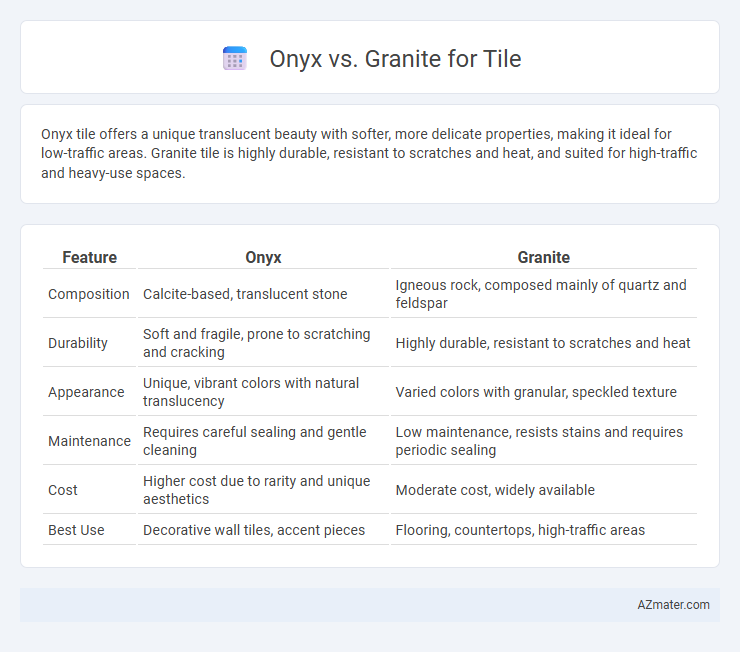Onyx tile offers a unique translucent beauty with softer, more delicate properties, making it ideal for low-traffic areas. Granite tile is highly durable, resistant to scratches and heat, and suited for high-traffic and heavy-use spaces.
Table of Comparison
| Feature | Onyx | Granite |
|---|---|---|
| Composition | Calcite-based, translucent stone | Igneous rock, composed mainly of quartz and feldspar |
| Durability | Soft and fragile, prone to scratching and cracking | Highly durable, resistant to scratches and heat |
| Appearance | Unique, vibrant colors with natural translucency | Varied colors with granular, speckled texture |
| Maintenance | Requires careful sealing and gentle cleaning | Low maintenance, resists stains and requires periodic sealing |
| Cost | Higher cost due to rarity and unique aesthetics | Moderate cost, widely available |
| Best Use | Decorative wall tiles, accent pieces | Flooring, countertops, high-traffic areas |
Introduction to Onyx and Granite Tiles
Onyx and granite tiles are popular choices for luxurious and durable surfaces in home and commercial designs. Onyx tiles showcase a translucent, rich veined appearance allowing light to pass through, creating a luminous ambiance ideal for decorative backsplashes or feature walls. Granite tiles feature a dense, granular composition with exceptional hardness and resistance to scratches and stains, making them perfect for high-traffic flooring and countertops.
Key Differences Between Onyx and Granite
Onyx and granite differ significantly in composition, with onyx being a translucent, calcite-based stone that offers a unique, glowing aesthetic, while granite is a much harder igneous rock composed mainly of quartz and feldspar, known for its durability. Onyx tiles are more susceptible to scratching and require delicate maintenance, making them suitable for low-traffic areas, whereas granite tiles are highly resistant to heat, scratches, and stains, ideal for high-traffic and kitchen environments. The price point of onyx is generally higher due to its rarity and distinctive appearance, while granite provides a more cost-effective and practical option for durable, everyday use.
Appearance and Color Variations
Onyx tiles showcase a translucent quality with rich, vibrant colors such as honey, amber, and green, offering dramatic light effects that create a luxurious ambiance. Granite tiles, on the other hand, present a more uniform appearance with speckled patterns in shades of gray, black, white, and occasionally pink or blue, providing a natural, earthy aesthetic. The distinct color variations in onyx deliver bold, striking visuals, whereas granite's subtle, granular variations ensure durability combined with timeless elegance.
Durability and Strength Comparison
Onyx tiles offer a unique translucent appearance but are significantly less durable and softer compared to granite, making them more prone to scratching and chipping in high-traffic areas. Granite tiles rank higher in strength, boasting exceptional hardness and resistance to impact, heat, and stains, which makes them ideal for flooring and countertops requiring long-lasting performance. For applications demanding superior durability and minimal maintenance, granite is the preferred choice over onyx.
Maintenance and Cleaning Requirements
Onyx tiles require careful maintenance due to their soft, porous nature, demanding gentle cleaning with pH-neutral agents to prevent etching and staining. Granite tiles offer superior durability and are more resistant to scratches and stains, allowing for easier cleaning with mild, non-abrasive detergents. Regular sealing enhances granite's longevity, while onyx needs more frequent sealing to maintain its polished appearance and avoid damage from moisture.
Cost and Value Analysis
Onyx tile typically costs between $40 to $100 per square foot, making it significantly more expensive than granite, which ranges from $20 to $50 per square foot. While onyx offers a unique translucent appearance and luxurious aesthetic, granite provides superior durability and lower maintenance, delivering greater long-term value for high-traffic areas. Considering installation complexity and the need for more frequent sealing, granite generally offers a cost-effective solution with balanced value for both residential and commercial tile applications.
Installation Considerations
Onyx tiles require more delicate handling and precise installation techniques due to their natural translucency and softer composition compared to granite, which is significantly harder and more durable. The installation of onyx often demands specialized adhesives and careful sealing to prevent damage and staining, whereas granite tiles offer greater flexibility in installation environments with standard grout and sealant formulations. Proper substrate preparation and skilled labor are essential for both materials to ensure longevity, but onyx installations typically incur higher labor costs and require more frequent maintenance.
Best Uses: Where to Install Onyx vs Granite Tiles
Onyx tiles are best suited for low-traffic areas such as bathrooms, powder rooms, and accent walls due to their translucent beauty and sensitivity to scratches and acids. Granite tiles excel in high-traffic spaces like kitchens, foyers, and flooring because of their durability, resistance to stains, and hardness. Choosing onyx enhances luxury and visual impact in decorative applications, while granite delivers long-lasting performance and strength for functional surfaces.
Pros and Cons of Onyx Tiles
Onyx tiles offer a unique translucent beauty and natural veining that create a luxurious, striking appearance unmatched by granite. They are softer and more porous than granite, making them prone to scratching, staining, and requiring regular sealing for durability. While onyx provides an exquisite aesthetic suitable for low-traffic areas, granite tiles deliver superior hardness and resistance, making them better suited for high-traffic and heavy-use spaces.
Pros and Cons of Granite Tiles
Granite tiles offer exceptional durability and resistance to scratches, heat, and stains, making them ideal for high-traffic areas and kitchen countertops. Their natural grain patterns and wide color variety enhance aesthetic appeal while requiring minimal maintenance. However, granite is porous, requiring periodic sealing to prevent moisture absorption and potential staining, and it is heavier and more expensive compared to other tile options like onyx.

Infographic: Onyx vs Granite for Tile
 azmater.com
azmater.com